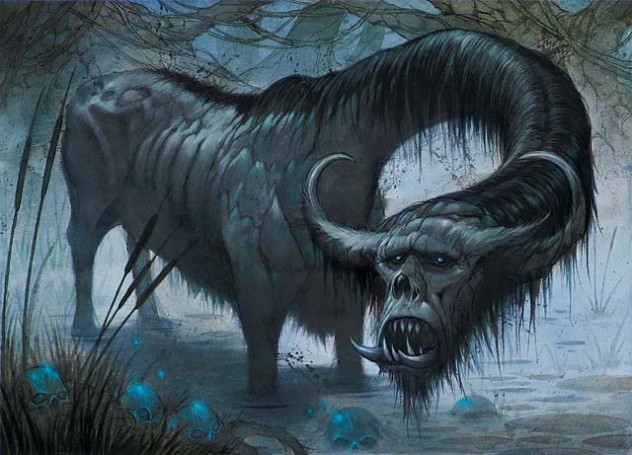 Mysteries
Mysteries  Mysteries
Mysteries  History
History 10 Surprising Stories About the Texas Rangers
 Humans
Humans 10 Philosophers Who Were Driven Mad by Their Own Theories
 Miscellaneous
Miscellaneous 10 Video-Game-Worthy Weapons and Armors from History
 Weird Stuff
Weird Stuff 10 Psychics Who Accurately Predicted Wartime Events
 The Arts
The Arts 10 Pieces of Art Inspired by a Broken Heart
 Health
Health 10 Science Fiction-Sounding New Medical Treatments
 History
History 10 Surprising Facts About the Father of Submarine Warfare
 Space
Space Ten Astonishing New Insights into Alien Worlds
 Weird Stuff
Weird Stuff 10 Bizarre Summer Solstice Rituals Still Practiced Today
 Mysteries
Mysteries Top 10 Haunting Facts About the Ghost Ship MV Alta
 History
History 10 Surprising Stories About the Texas Rangers
 Humans
Humans 10 Philosophers Who Were Driven Mad by Their Own Theories
Who's Behind Listverse?

Jamie Frater
Head Editor
Jamie founded Listverse due to an insatiable desire to share fascinating, obscure, and bizarre facts. He has been a guest speaker on numerous national radio and television stations and is a five time published author.
More About Us Miscellaneous
Miscellaneous 10 Video-Game-Worthy Weapons and Armors from History
 Weird Stuff
Weird Stuff 10 Psychics Who Accurately Predicted Wartime Events
 The Arts
The Arts 10 Pieces of Art Inspired by a Broken Heart
 Health
Health 10 Science Fiction-Sounding New Medical Treatments
 History
History 10 Surprising Facts About the Father of Submarine Warfare
 Space
Space Ten Astonishing New Insights into Alien Worlds
 Weird Stuff
Weird Stuff 10 Bizarre Summer Solstice Rituals Still Practiced Today
9 Forgotten Mythological Animals
Mythology has produced some famous creatures in its labyrinthine history—the Hydra, Hades and his many-headed hound, Anansi the spider, and many more. But there are many strange animals we never hear about. Let’s introduce the unsung beasts of legend.
9 Crocotta
Classical Mythology

Descriptions of this weird dog-being vary, but most accounts describe the crocotta—or leucrotta—as a dog that travels around India looking for people to kill and eat. The crocotta is another of those creatures that could have been either a fabrication of explorers or a misinterpretation by ancient zoologists. It is said to mimic human noises to attract its victims and devour them. If you manage to survive—which is unlikely—you can rip out its crystal eyes and put them under your tongue. Congratulations, you can now tell the future.
8 Yale
Classical Mythology

A fascinating creature described in Pliny’s Natural History, the yale—also called a centicore—is said to be a deer-like creature with an awesome superpower. His horns, already deadly weapons, can swivel around in any direction to hit some unsuspecting hunter or foolish myth-seeker. So be careful next time you decide to go hunting with your buddies—you could end up with a face full of sharp and spiky horn.
7 Catoblepas
Classical Mythology

Cows aren’t the most menacing creatures. Come on, with their adorable faces and deliciousness they don’t exactly scream danger—unless you’re talking about Mad Cow Disease, or their mythical cousin the catoblepas. Mythology produces some strange animals, but this one is really out there. The catoblepas was a cow that grazed on the banks of rivers. Its breath, because of the plants it ate, was horribly toxic, and its stare could kill you. It’s thought that tales of the creature arose from sightings of wildebeest, which seems somewhat unfair to the wildebeest.
6 Ao Ao
Guarani Mythology

Nothing like the ao ao comes along even in bestiaries or the Dungeons & Dragons Monster Manual. Said to look like a sheep or a peccary (a type of jungle pig), the ao ao is a dangerous, fanged monster that would like to make you into its dinner. The name is said to come from the noise it makes, and to stop it you have to run around a sacred tree. It will then become disoriented and stop chasing you. The only question then is how you’re going to get out of a Paraguayan forest.
5 Indian Ants
Medieval Mythology

Warning: Creepy-crawlies of gigantic proportions ahead. Ants are among nature’s greatest builders and workers but, like most insects, they give some people the heebie-jeebies. Fortunately for those people, ants are usually small and quite harmless—unless you go to South America or encounter fire ants or myriad other nasty critters.
Unfortunately, the ancients decided that regular ants having lethal cousins wasn’t enough and decided to weave a tale of giant ants guarding gold. The legends say that, somewhere out there in the world, giant ants protect massive hoards of treasure in distant deserts, spots where man has rarely been. If you can get past the ant, the gold is yours. Of course, few get past it. Why? Well . . . giant ant. Need we say more?
4 Roc
Indian And Persian Mythology

Let’s say you’re in India, and by sheer luck you run into an Indian elephant. After sharing a few peanuts and becoming lifelong friends, you turn away for a moment only to find that the elephant is gone. You look up to see the unfortunate animal being carried away. You have encountered a roc, a giant bird of myth and legend that was mentioned by the famed explorer Sir Richard Francis Burton. The roc is, of course, highly dangerous and would view you as a wonderful complement to its carnivorous brunch—maybe you’ll find yourself in its nest as a side to some elephant tartar. Or you could run like the dickens when you see it. We prefer the latter.
3 Aspidochelone
Greek Mythology

This is one ripped straight out of a storybook. Let’s say you and your buddies are out at sea, and you come across an island. The map doesn’t say there’s an island where you are, but you foolishly decide to dock there. After a while, the island begins to move. Say hello to the scaly wonder that is an aspidochelone. The creature is an enormous turtle whose back resembles an island, often developing foliage and even becoming home to wildlife over time. When unfortunate sailors light a fire on its back, the aspidochelone swims back underwater, drowns the sailors, and destroys their ship. Not exactly the tropical vacation anyone wanted.
2 Firebird
Russian Mythology

We all know about the phoenix, the legendary bird that rises from the ashes after burning itself to death, but few people have heard of its Russian cousin, the firebird. The subject of Russian fairytales, it is said to glow wonderfully in the darkness of the forest and is often involved in great and impossible quests. Sometimes it is a guide; at other times it is the subject of the quest, its feathers being a highly valued prize. Firebird farm, anyone?
1 Huginn And Muninn
Norse Mythology

The Norse All-Father Odin is a pretty awesome guy—he sacrifices his eye for sacred knowledge, he’s head of a fascinating pantheon, and he’s got two amazing pet birds. Huginn and Muninn are the source of Odin’s omniscience, representing wisdom (Huginn) and memory (Muninn) and are two of the most important creatures in Norse mythology. They act as extensions of Odin, and he constantly worries that the day may come when they don’t come back.
Vlad Vekshtein is an eccentric writer and mythology buff. He’s quite sad that he didn’t get to go to the San Diego Comic-Con, but Listverse makes up for it quite nicely. He’s always looking for new ideas for lists, so sound off in the comments!








